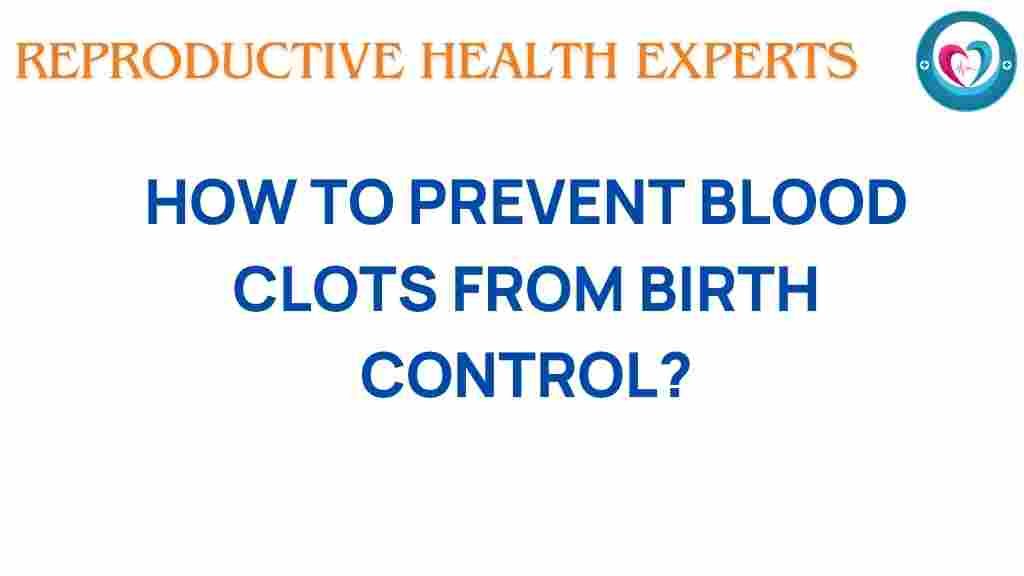Uncovering the Secrets: How to Prevent Blood Clots from Birth Control
Birth control methods, particularly hormonal contraceptives that contain estrogen, are widely used for family planning and managing various health conditions. While they offer many benefits, there is a notable health risk associated with them: the potential for blood clots. Understanding how to prevent blood clots from birth control is crucial for maintaining your health and safety. In this article, we will explore the connection between blood clots and birth control, the associated health risks, and effective prevention strategies.
What Are Blood Clots and Why Are They a Concern?
Blood clots are gel-like clumps of blood that form when platelets and proteins in the blood stick together. While they play a vital role in stopping bleeding, abnormal blood clotting can lead to serious health issues, including:
- Deep Vein Thrombosis (DVT): Clots that form in deep veins, often in the legs.
- Pulmonary Embolism (PE): A clot that travels to the lungs, which can be life-threatening.
- Stroke: A blockage of blood flow to the brain due to a clot.
- Heart Attack: A blockage that affects blood flow to the heart.
The risk of developing blood clots can increase with certain birth control methods, especially those containing estrogen. Awareness of this risk is essential for anyone considering or currently using hormonal contraceptives.
Understanding the Connection Between Hormonal Contraceptives and Blood Clots
Hormonal contraceptives, such as pills, patches, and rings, often contain estrogen and progestin. Estrogen can affect blood clotting factors and increase the likelihood of clot formation. Here are some key points:
- Estrogen’s Role: Estrogen can increase the production of certain proteins that promote clotting.
- Types of Contraceptives: Combination birth control pills (which contain both estrogen and progestin) have a higher risk compared to progestin-only methods.
- Individual Risk Factors: Factors such as age, smoking, obesity, and a personal or family history of blood clots can elevate the risk further.
Symptoms of Blood Clots
Recognizing the symptoms of blood clots is crucial for early intervention. Common symptoms include:
- DVT: Swelling, pain, warmth, and redness in the affected leg.
- PE: Sudden shortness of breath, chest pain, rapid heartbeat, and coughing up blood.
- Stroke: Sudden numbness or weakness, trouble speaking, or severe headache.
- Heart Attack: Chest pain, discomfort in the arms, back, neck, or jaw, and shortness of breath.
If you experience any of these symptoms, seek medical attention immediately. Awareness of these symptoms can save lives.
Preventing Blood Clots While Using Birth Control
While the risk of blood clots associated with birth control can be concerning, there are effective prevention strategies you can adopt. Here’s a step-by-step guide to help you minimize your risk:
1. Consult Your Healthcare Provider
Before starting any form of birth control, discuss your medical history and risk factors with your healthcare provider. They can help you choose the safest option based on your individual needs.
2. Choose the Right Contraceptive
If you have a higher risk of blood clots, consider alternatives to estrogen-containing contraceptives, such as:
- Progestin-only pills
- Intrauterine devices (IUDs)
- Implants
These methods have a lower risk of clotting compared to combination pills.
3. Maintain a Healthy Lifestyle
Healthy lifestyle choices can significantly reduce your risk of blood clots:
- Stay Active: Regular physical activity promotes healthy circulation.
- Avoid Smoking: Smoking increases the risk of clot formation, especially when combined with hormonal contraceptives.
- Manage Weight: Maintaining a healthy weight can reduce your risk of clots.
4. Monitor Your Health
Keep track of your health and any changes you notice. Regular check-ups with your healthcare provider can help identify potential issues early.
5. Be Aware of Travel Risks
Long periods of sitting, such as during air travel, can increase the risk of blood clots. Consider these safety tips:
- Stay hydrated by drinking plenty of water.
- Move around frequently during long trips.
- Wear compression stockings to improve circulation.
6. Know Your Body
Understanding your body and recognizing changes is vital. If you notice any symptoms of blood clots, contact your healthcare provider promptly.
Troubleshooting Tips for Birth Control Users
If you’re using hormonal contraceptives and have concerns about blood clots, consider the following troubleshooting tips:
- Track Symptoms: Keep a diary of any unusual symptoms or side effects you experience.
- Communicate with Your Provider: Don’t hesitate to reach out to your healthcare provider about any concerns.
- Consider Alternative Methods: If you experience side effects, discuss switching to a different form of birth control.
Conclusion
Understanding the relationship between blood clots and birth control is essential for anyone using hormonal contraceptives. By being aware of the health risks associated with estrogen-containing methods and taking proactive steps for prevention, you can significantly reduce your risk of developing blood clots. Always consult your healthcare provider to choose the best contraceptive option for your health needs and lifestyle.
For more information on birth control options and safety, visit this resource. Stay informed, stay safe, and prioritize your health!
For personalized advice, consider visiting this external site to connect with healthcare professionals who can guide you based on your individual circumstances.
This article is in the category Prevention and created by ReproductiveHealthExperts Team
